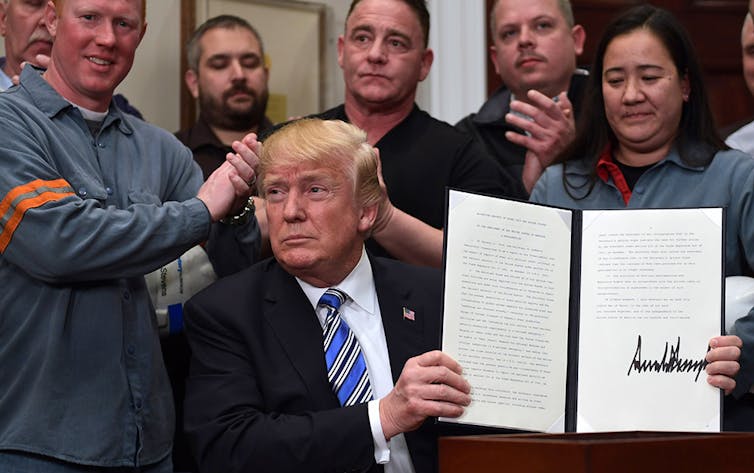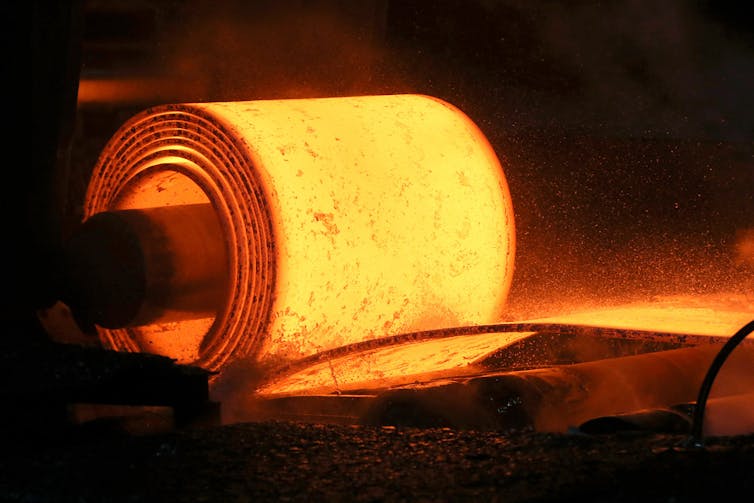Tariffs won't save American steel jobs. But we can still help steelworkers
- Written by Morten Wendelbo, Lecturer, Bush School of Government and Public Service; Research Fellow, Scowcroft Institute of International Affairs; and, Policy Sciences Lecturer, Texas A&M University Libraries, Texas A&M University
President Donald Trump has been promising to save American manufacturing, and the steel industry in particular, since the presidential campaign[1]. His attempt to follow through on that promise was the March 8 tariff increase on foreign steel and aluminum, arguing that the tariffs were necessary[2] to protect U.S. industries and workers.
Trump joins a long line of presidents[3], both Republican and Democrat, who have used trade policy in an attempt to create or protect jobs – almost always in vain[4].
Research shows that tariffs only delay[5] the industries’ inevitable decline. At best, Trump’s tariffs will only hurt industries dependent on steel and aluminum, like auto and construction, which together employ more than 7 million workers[6] – compared with steel’s 160,000. At worst, it will spark a trade war[7] that will harm many other industries and, ultimately, mean higher prices for every single American.
Our review[8] of recent research on the topic shows that the choice between tariffs and abandoning workers is a false one. More targeted alternative policies are available that can protect workers without damaging the U.S. economy – or sparking a trade war.
 President Donald Trump holds up his proclamation on steel imports.
AP Photo/Susan Walsh
President Donald Trump holds up his proclamation on steel imports.
AP Photo/Susan Walsh
Politics of protection
Regardless of political party, promising to protect vulnerable manufacturing industries – along with blaming foreign trade for their woes – has always been an effective vote-winning strategy.
Trump’s rivals in the 2016 campaign made similar promises[9] to shield American workers from foreign competition.
Sixteen months after winning the election, Trump has followed through on his pledge by slapping a tariff of 25 percent on imported steel and 10 percent on aluminum. Both industries have experienced rapid declines[10] in employment in recent decades.
Reality, however, isn’t so simple.
US manufacturing is not in decline
Despite the political rhetoric, data from the Federal Reserve show that American manufacturing is hardly in decline. In fact, U.S. industrial production is at an all-time high[11] and has grown pretty steadily for more than a century.
In 2017, the American economy churned out twice as much industrial production as it did in 1979. That means the economy produced more items and at a higher value than ever before in everything from steel to furniture to cheese.
Instead, what has declined precipitously are manufacturing jobs[12]. Employment in the sector dropped 36 percent from its peak in 1979 through January 2017.
The reason these two facts coexist is that industrial productivity has skyrocketed, with the average worker in 2017 producing roughly 300 percent more than someone in 1979 did.
Steel’s story
American steel tells a similar story – with a twist.
As opposed to manufacturing in general, American steel production has declined from its heyday in the 1970s[13].
That drop, however, took place in the early 1980s, not in the last three decades when trade expanded rapidly. Thus, it is difficult to see how trade could be a main driver behind the low output.
More importantly, the number of steel jobs has fallen at a much greater pace thanks to significant increases in productivity. Each ton of steel produced today takes a mere 1.5 worker hours[14], whereas it took more than 10 hours in 1980. Just as with manufacturing more broadly[15], technology and automation – not trade – explain the lion’s share of job losses.
Still, it is hard to deny the close relationship between trade and manufacturing output. More trade means better salaries, lower prices and better-quality products across most of the economy. And the overwhelming majority of research in economics supports the notion that trade and the total size of an economy are closely linked[16].
This connection is because of something economists call “comparative advantage.” As trade increases, countries will tend to make more of what they are most effective at producing. This expands the overall amount of production across the world and lowers prices for consumers. This is part of why world steel production has more than doubled since 1980[17].
But this comes at a cost: The industries and workers in countries that are less efficient at something will suffer, as has been the case with U.S. steel, whose share of world production has decreased from 16 percent in 1979[18] to just 4.8 percent in 2016[19].
In other words, while international trade is a crucial part of economic development, benefiting almost everyone in the U.S. economy, some inevitably lose out. In recent decades, this same fate has befallen other U.S. industries, typically those that are very labor intensive, such as the textile and apparel industries[20].
 A steel coil is unrolled at a Pennsylvania steel mill.
Reuters/Aaron Josefczyk
A steel coil is unrolled at a Pennsylvania steel mill.
Reuters/Aaron Josefczyk
Manufacturing clusters
Compounding the negative impact, manufacturing industries tend to be in concentrated geographic areas[21].
Companies often benefit[22] from being close to their competitors because that attracts lots of skilled workers, making manufacturing easier and cheaper. This is why so many car manufacturers are centered around Detroit and why a single city in China[23] produces 60 percent of the world’s buttons.
If steel production were spread out across the country and not concentrated in a few states[24], it would be easier for displaced workers to find new jobs quickly.
Instead, steelworkers are centered around places[25] like Indiana, Pennsylvania, Ohio and Michigan. And some communities, such as Gary, Indiana, which are built around the steel industry and the workers it employs, are particularly at risk.
Tariffs, however, cannot hope to keep technology and automation at bay, and research overwhelmingly shows[26] that tariffs are ineffective at mitigating the negative impact from trade.
The last time the U.S. imposed a steel tariff, in 2002, the economy lost more jobs[27] than the entire steel industry employs.
What can be done
That does not mean the government should throw up its hands. There are tangible and straightforward policies that national or state governments can pursue to help displaced steelworkers, without hurting everyone else in the process.
The key is to first understand the real challenge. It isn’t that these workers are suddenly without employment – Americans on average hold a job for just 4.2 years[28] – it’s that they cannot easily find new work, particularly when it requires moving to a new industry or different part of the country. And the reasons are twofold: a lack of information and the high costs of relocation.
Economists have found[29] that workers – particularly low-skilled and less-educated ones – often fail to find new work simply because they don’t know how to locate open positions or effectively use common services like private job search engines.
And because laid-off steelworkers are often geographically concentrated, finding new work means going where the jobs are, which can be prohibitively expensive. On average, relocation costs (including the psychological cost of having to adjust to a new community) are more the twice the yearly income[30] of a typical U.S. worker.
While the government is powerless to preserve old steel jobs, it has powerful tools at its disposal to address these problems.
Currently, the federal government offers trade adjustment assistance[31] to provide workers displaced by trade with training and some extended unemployment benefits. But research shows that the program doesn’t provide enough benefits to offset costs incurred by workers[32], who call it “burial insurance.”[33]
To solve the first problem, government agencies could do more to bring information about available jobs to the displaced workers, which would substantially increase the odds that they find new positions – and at little cost[34].
The relocation problem requires more money in the form of direct assistance to the workers to help them move. While it may initially sound expensive – perhaps tens of thousands of dollars per worker – it is actually much less costly than tariffs. An Obama-era tariff on Chinese tires, for example, cost the economy more than US$900,000 per job[35] temporarily saved. We could save taxpayers (who, of course, are consumers) money by giving each displaced worker $100,000 to find and move to a new job.
As has been repeated incessantly, trade creates winners and losers[36], but substantially more of the former than the latter. If the government used just a fraction of the benefits accrued to the winners and reinvested it in the few workers who end up worse off, there would be no losers at all.
References
- ^ since the presidential campaign (theconversation.com)
- ^ arguing that the tariffs were necessary (fortune.com)
- ^ a long line of presidents (theconversation.com)
- ^ almost always in vain (www.baltimoresun.com)
- ^ only delay (wol.iza.org)
- ^ employ more than 7 million workers (www.washingtonpost.com)
- ^ spark a trade war (theconversation.com)
- ^ Our review (scholar.google.com)
- ^ made similar promises (www.nytimes.com)
- ^ have experienced rapid declines (www.politifact.com)
- ^ is at an all-time high (fred.stlouisfed.org)
- ^ manufacturing jobs (fred.stlouisfed.org)
- ^ declined from its heyday in the 1970s (fred.stlouisfed.org)
- ^ takes a mere 1.5 worker hours (apnews.com)
- ^ manufacturing more broadly (www.technologyreview.com)
- ^ total size of an economy are closely linked (www.aeaweb.org)
- ^ more than doubled since 1980 (www.worldsteel.org)
- ^ 16 percent in 1979 (www.worldsteel.org)
- ^ 4.8 percent in 2016 (www.worldsteel.org)
- ^ textile and apparel industries (www.theguardian.com)
- ^ concentrated geographic areas (www.aeaweb.org)
- ^ often benefit (www.nber.org)
- ^ single city in China (www.cbsnews.com)
- ^ concentrated in a few states (www.nwitimes.com)
- ^ centered around places (www.marketwatch.com)
- ^ research overwhelmingly shows (wol.iza.org)
- ^ economy lost more jobs (theconversation.com)
- ^ hold a job for just 4.2 years (www.bls.gov)
- ^ Economists have found (papers.ssrn.com)
- ^ twice the yearly income (www.aeaweb.org)
- ^ trade adjustment assistance (theconversation.com)
- ^ doesn’t provide enough benefits to offset costs incurred by workers (www.wsj.com)
- ^ who call it “burial insurance.” (theconversation.com)
- ^ at little cost (openknowledge.worldbank.org)
- ^ cost the economy more than US$900,000 per job (www.uschamber.com)
- ^ trade creates winners and losers (research.stlouisfed.org)
Authors: Morten Wendelbo, Lecturer, Bush School of Government and Public Service; Research Fellow, Scowcroft Institute of International Affairs; and, Policy Sciences Lecturer, Texas A&M University Libraries, Texas A&M University


